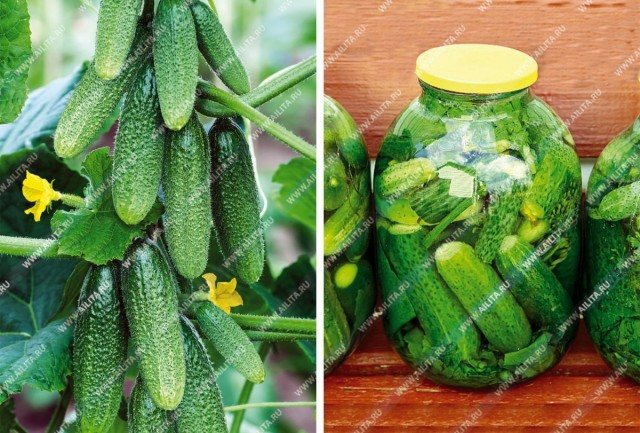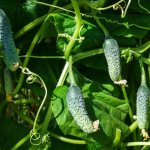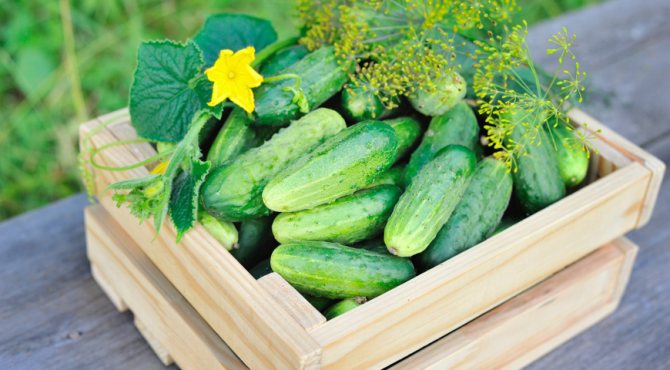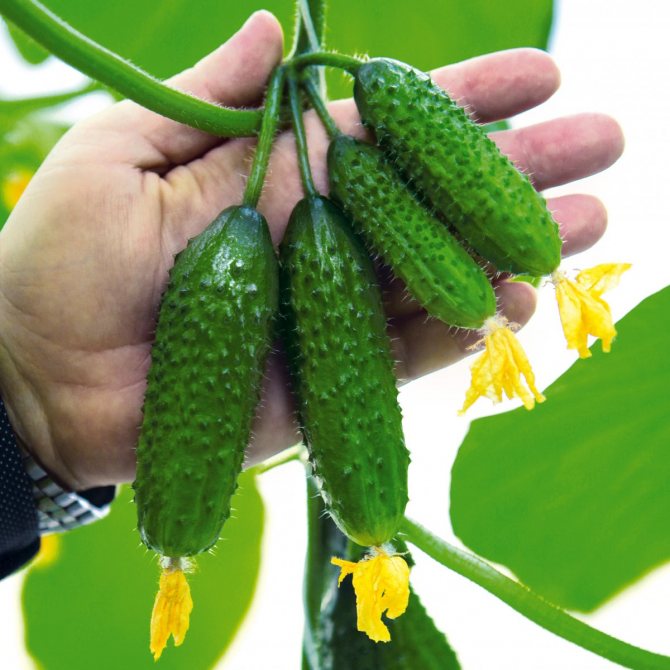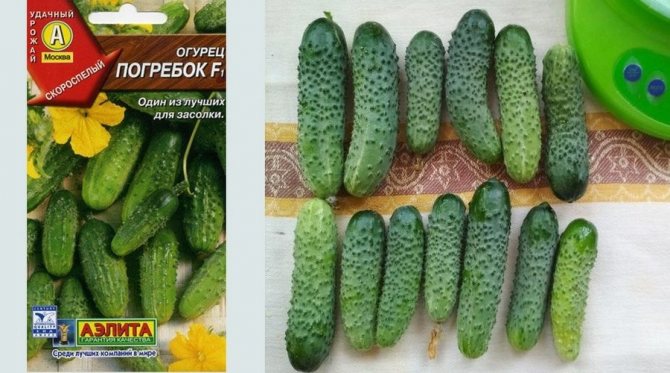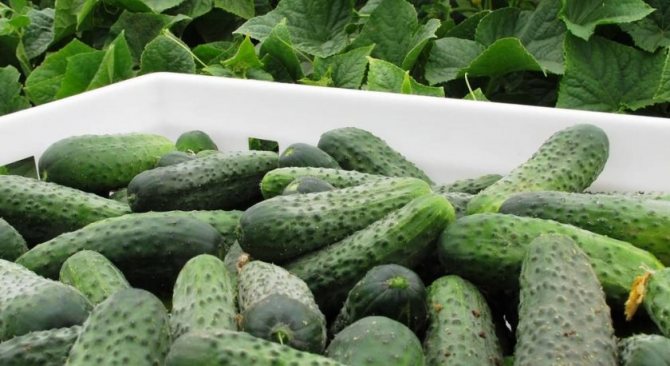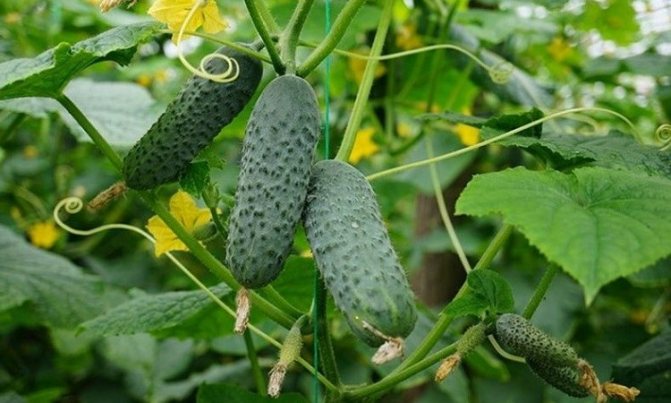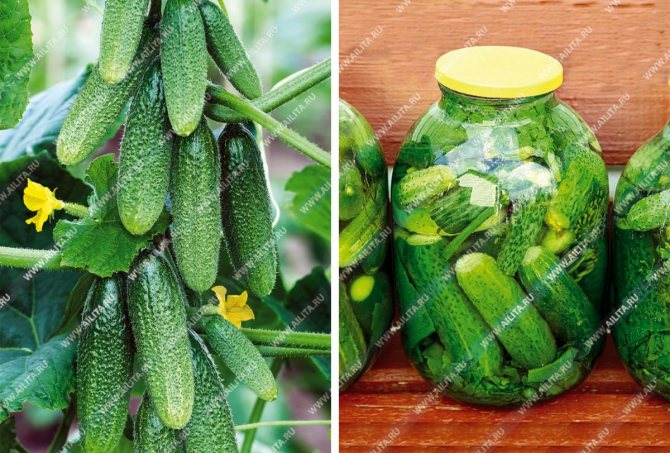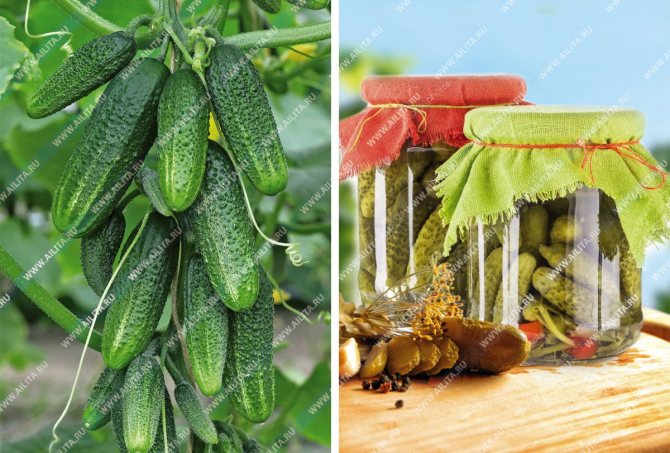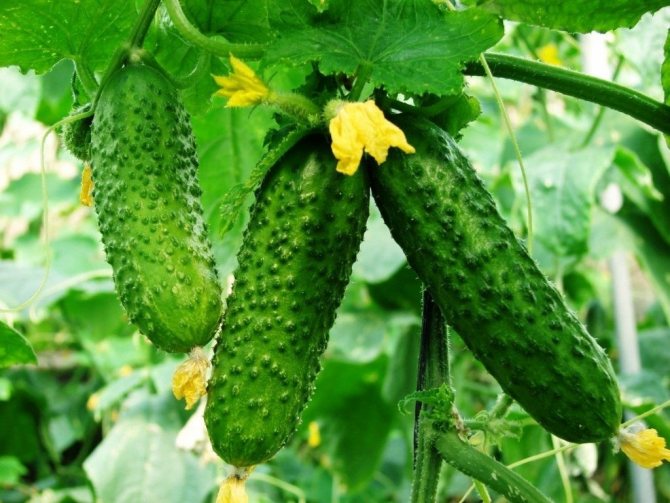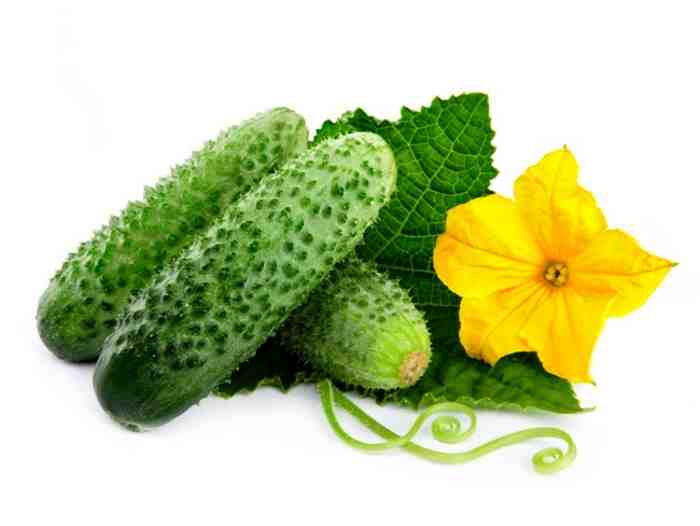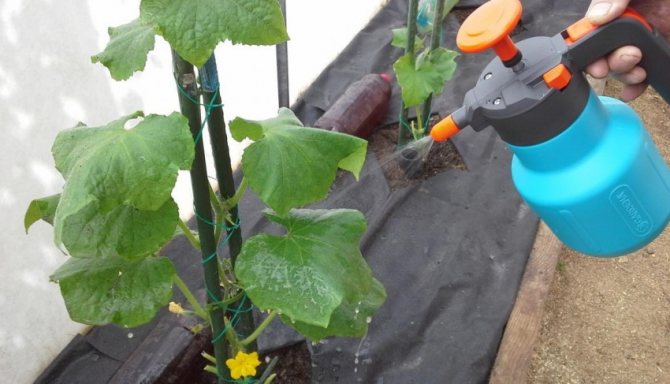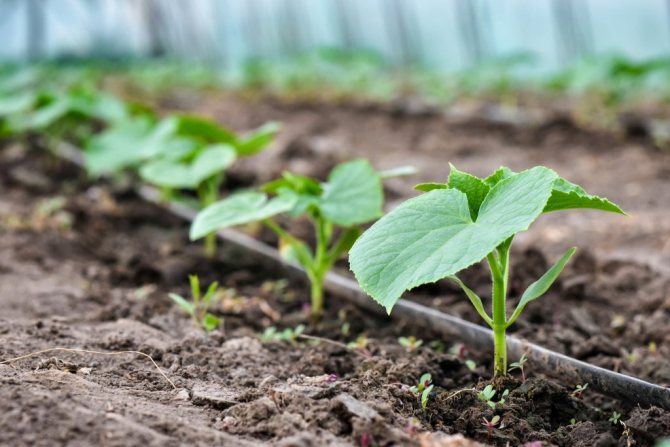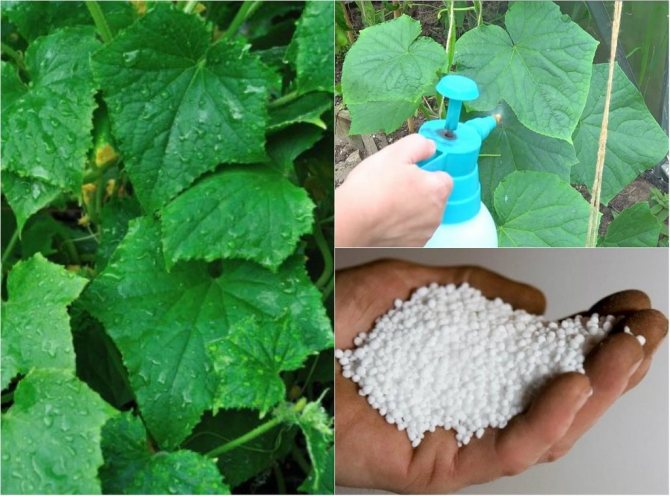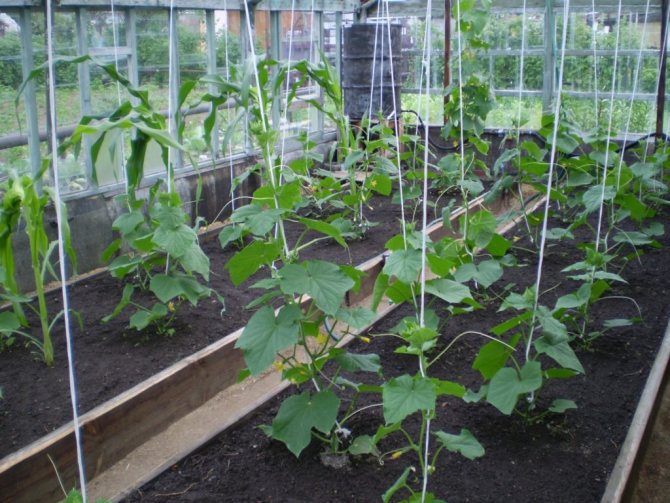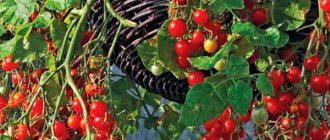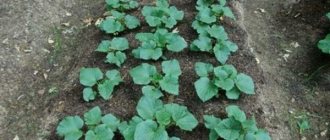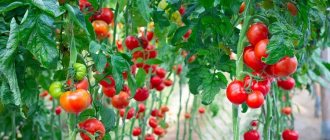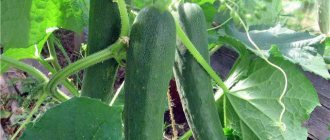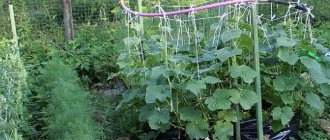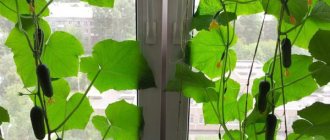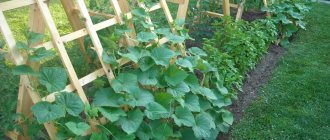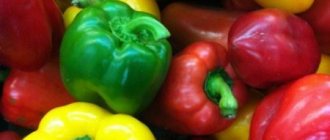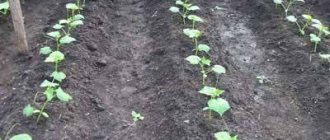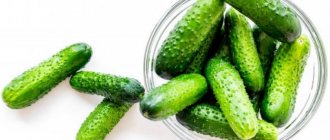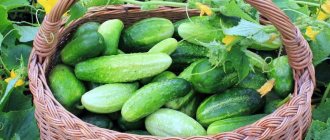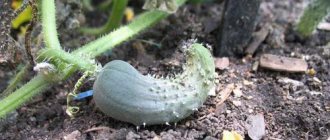»Vegetable growing» Cucumbers »Varietal characteristics of Sigurd cucumber
0
200
Article rating
Cucumber Sigurd belongs to hybrid varieties with early fruiting. It was bred by breeders of the Dutch company Enza Zaden for planting on an industrial scale. It has excellent taste and high tasting scores.
Varietal characteristics of Sigurd cucumber
Description and characteristics of the variety
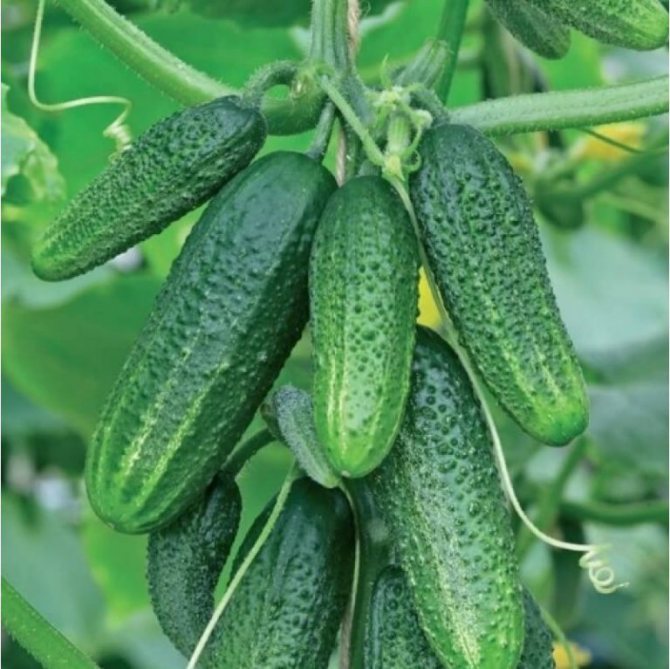
The hybrid variety Espagnolette F1 is parthenocarpic and produces fruits from each female flower without pollination. It can be grown under film, in winter greenhouses and in open ground in personal plots.
In terms of ripening, the cucumber is mid-early, close to mid-season - from 53 to 55 days. Fruits grow in bunches of up to three greens in each. The length of the cucumbers is 7-11 cm, weight is about 85-95 g. They are covered with many miniature tubercles, ending in white thorns. The taste is wonderful, fresh, devoid of bitterness. The pulp is juicy and firm. The fruits are suitable for all types of processing and preparation, as well as fresh meals.
Cucumber Fun Dwarfs F1®
Ultra-early maturing parthenocarpic hybrid Funny gnomes F1 amateurs prefer to collect only small cucumbers. Perfect for both indoor and outdoor cultivation. The zelents of this hybrid do not exceed 8-9 cm in length and never outgrow. The first fruits can be harvested as early as 38-40 days after germination. In each node, a whole bunch of cucumbers is formed, from 3 to 5 pieces. Zelentsy are homogeneous, small-tuberous, white-thorny, with a thin skin, juicy and crunchy pulp, with excellent taste. It is these fruits that are very popular with our summer residents. Cucumber Funny Gnomes proved to be excellent in different climatic regions, resistant to sudden changes in weather conditions and easily adapts to any growing conditions.
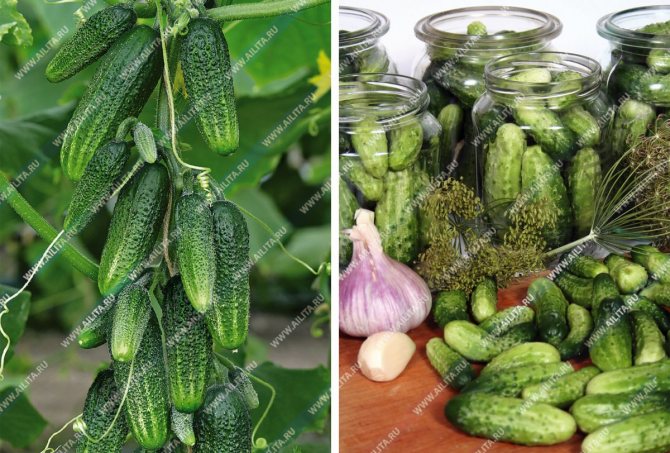

Landing
Seeds can be sown directly to a permanent place or for seedlings. The seedling method is recommended if the region has a cold climate, it provides an earlier harvest.
For seedlings, cucumbers are sown 20-30 days before transplanting to the garden. The soil is prepared like this:
- 2 parts of humus;
- 2 parts of peat;
- 1 part sawdust;
- 2 tbsp. wood valley and 1.5 tbsp. nitrophosphate for 10 liters of substrate.
Rules for obtaining healthy seedlings:
- Seeds are sown in containers with a diameter of 10-12 cm.
- Before germination, they provide a temperature of +25, after - + 18-20.
- Keep the pots on a lighted windowsill, and if the daylight hours are less than 8 hours, turn on the lamps.
- After the second leaf, top dressing is applied: 1 tsp. nitroammophoska or nitrophoska for 1 liter of slightly warmed water.
To grow cucumbers immediately in the open field, they dig it up, loosen it and enrich it with peat and humus. For looseness, compost is introduced in the fall or sawdust in the spring.
When the soil has cooled, the seeds are planted according to the 60 by 60 scheme. In a greenhouse for 1 square. m place 2-3 bushes, in the open field - 4-5.
Pests and diseases
Pests
Slugs
The main enemy of the harvest of greens is slugs. To combat them, the beds around the perimeter are sprinkled with wood ash, the leaves are also dusted. This measure also saves from aphids.
Mite
Sometimes the plant infects a spider mite. You can find it by the thin cobwebs that envelop the bush. To combat the pest, plants are sprayed with special chemicals:
- chopsticks "Plant-Pin" (they are inserted under the bush at the root before watering);
- Etisso (inserted under the bush before watering);
- Aktara (dissolved in water, after which the bush is sprayed).
Diseases
The crop also suffers from disease. They occur with improper care or insufficient feeding:
- Powdery mildew - small white spots on leaves, stems and fruits. The causes of the disease are temperature drops and excessive soil moisture. The affected plants are removed from the garden and burned, and the rest are treated with sulfur powder or sprayed with mullein infusion: 200 g of mullein per 10 liters of warm water.
- White rot - gray spots covered with mucus. It attacks plants in thickened plantings due to insufficient ventilation. As a means of struggle, the beds are thinned out.
- Root rot - rotting of the part of the stem where it comes into contact with the ground. The reasons lie in watering with cold water or a strong drop in temperature at night during a cold summer. The water is heated before watering, the beds are mulched.
If you follow the rules of care, you can save the crop from pests and diseases.
Growing and care
Cucumbers require regular watering with warm water. It is carried out in the mornings or evenings under the root 2-3 times a week. In hot weather, you can increase the intensity, and in rainy weather outdoors, lower it.
They are fed at least 2-3 times after landing in the ground:
- Two weeks after the rooting of the seedlings, nitrogen fertilizer is applied - manure diluted with water, or a urea solution.
- With the appearance of the first flowers, they are watered with a solution of nitrophosphate, superphosphate or other complex fertilizer with phosphorus.
- With the onset of fruit ripening, a little nitrogen and a little more potassium are added: potassium nitrate, potassium sulfate.
In greenhouses, bushes require shaping. They are led into 1 stem along a vertical trellis, the lower shoots are cut off, and the upper ones are pinched, allowing 2-3 leaves to be released. It is not necessary to form in the open ground.
Cucumber beds can be found in almost every garden. Juicy crunchy cucumbers add freshness to any dish. Salted and pickled greens are no less tasty. Espagnolette belongs to the varieties intended for quick salting. Caring for the plant is simple, but it's worth familiarizing yourself with the description of the culture.
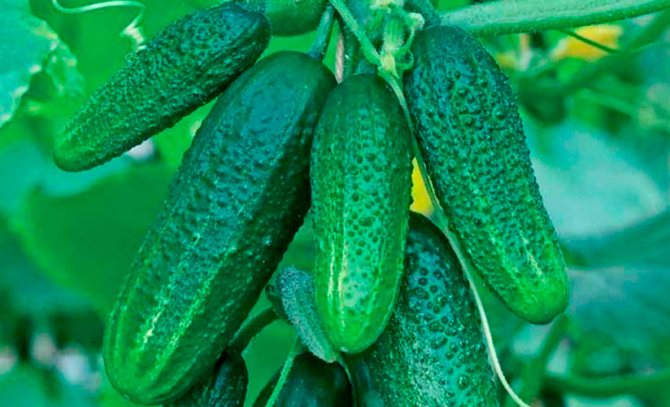

Characteristics of the species
The early ripening high-yielding variety Pogrebok F1 is popular among gardeners due to its biological and commercial properties. The hybrid species is grown under film shelters that protect vegetables from frost, and in the open field.
The main characteristics of a cucumber:
- the yield of a plant under favorable conditions can reach 15 - 17 kg per 1 m2 - due to this increase, the variety is classified as high-yielding;
- the ripening of vegetables occurs quickly - after 43 - 48 days from planting in the soil, the first crop can be harvested;
- the resistance of a hybrid to diseases is the main advantage of breeding work;
- a universal type suitable for fresh consumption, for canning and pickles.
The resulting hybrid has an indeterminate bush and a medium-branched structure of lashes with small leaves. The plant is characterized by a mixed type of flowering with a predominance of female flowers, especially on the lateral lashes.
Description of the hybrid
When creating the Espagnolette cucumber, Russian breeders took into account the peculiarities of the country's unpredictable climate. Plants are available for cultivation both in the south and in the middle lane.
- stems of medium height, foliage is rather dense, leaves are small, pointed;
- ripening takes 53-55 days on average;
- abundant fruiting, amicable;
- the ovary is formed in bunches, each from 3 fruits;
- cucumbers are covered with very small, but frequent tubercles, there are white thorns.
Attention! Cucumber Espagnolette does not require insect pollination.
| By type of growth | Medium-weight |
| By branching type | Medium branched |
| By type of pollination | Parthenocarpic |
| Landing scheme | 50x30 cm |
| Weight, length and shape fetus | 85-95 g, 7-11 cm, cylindrical, tubercles are small and frequent |
| Ripening period | Mid-season (53-55 days) |
| Using | Universal |
| Drop off location | Exhaust gas / greenhouse / greenhouse |
| Diseases | Immune to cladosporium, mosaic virus, resistant to both types of powdery mildew |
| Flowering type | Female |
| Yield | In the greenhouse from 13 kg / m 2; in exhaust gas - up to 14 kg / m 2 |
The best cucumber varieties that do not require pollination
When choosing seeds of self-pollinated cucumbers for open ground, it is imperative to pay attention to the peculiarities of cultivation of one or another species. If it is intended exclusively for greenhouse structures, then this variety will not work for unprotected soil.
Next, cucumber seeds will be considered the best self-pollinated for open ground, which are recognized by many farmers and are successfully used in private farms and in the industrial production of vegetables.
Variety Red mullet F1
This variety has practically no drawbacks. This is confirmed by the reviews about the Red mullet f1 cucumber, which speak of its versatility in growing and using. The variety is early ripe, fruits appear 45-48 days after the start of active growing season. It belongs to the parthenocarpic species and can grow both in protected ground and without greenhouse shelters. Suitable for cultivation in all regions of the country. It is characterized by long-term fruiting - 60 days or more.
By type of fruit - gherkin cucumber. Ovaries are formed in bundles of 8-10 (sometimes 12) pieces. This feature significantly increases the yield. During the first 30 days, you can collect about 6 kg of vegetables from a bush, and the total yield from 1 sq. M. - up to 12 kg.
Variety Harmonist F1
No less commendable reviews about the F1 Harmonist cucumber are found on the websites and forums of gardeners and gardeners.
An early ripe hybrid - the growing season is 40 days. Designed for any growing conditions: greenhouse, greenhouse, uncovered ground. The type of flowering is female, the method of fruit setting is parthenocarpic. In each axil of the leaf, an average of 6 cucumbers are tied. All of them are distinguished by uniformity in shape, weight and color. The shape is cylindrical, the weight of each fruit is 90-100 grams. The color is bright green at the base, whitish at the top. The skin is densely covered with small tubercles. The taste is sweet, the bitterness is not peculiar, the seeds are practically not felt. The variety gives a good yield of vegetables - up to 13 kg / sq.m.
Vyatsky F1 grade
The purpose of breeding Vyatsky F1 cucumber was to obtain a plant that could easily tolerate poor soil composition, sudden drops in temperatures, irregular watering, pest attacks and had good immunity against most diseases.
The cultivation results did not have to depend on the cultivation method. With or without a greenhouse, it should produce a bountiful harvest consistently.
The breeders managed to combine all the listed requirements in one variety, as evidenced by reviews of the Vyatsky f1 cucumber on the Internet.
In addition to all the listed advantages, this hybrid is also characterized by other positive qualities: early maturity (about 30 days), female type of flowering, unpretentious care, versatility of the use of fruits.
Cucumbers of the variety are medium-sized (120g / 12cm), cylindrical, green, lumpy. The pulp is without cavities, juicy, delicate in taste.
Grasshopper F1 variety
Good reviews about the Grasshopper f1 cucumber recommend growing this parthenocarpic variety in open backyard plots. He ties the fruits in bunches of 2-6 pieces. The cucumbers are green, bordered with lightly colored stripes, the tubercles are large, with white thorns. The mass of one vegetable is 100 grams, the length is 11-12 cm. The yield is high: one square meter with plantings gives from 10 to 13 kg of fruits. Good immunity to all diseases, except for peronosporosis. The variety fights with this "ailment" with varying success.
Patti F1 variety
After reading reviews about Patti f1 cucumber, you can come to the conclusion that he is one of the most suitable for our conditions. Wherever he is planted, he will demonstrate a good result everywhere. A greenhouse, open land, a loggia and even a windowsill - all these conditions are suitable for an unpretentious hybrid. In terms of the timing of the harvest, it belongs to the mid-early. The period from the first shoots to the first harvest takes from 40 to 44 days.
Blossoms mainly with female flowers, parthenocarpic, ovaries are collected in bunches. The cucumbers are medium, each weighing 50-90 grams. The skin is thin, dark, green, with small stripes, covered with very small and frequent tubercles. The pulp is crunchy, contains a small amount of seeds, and is sweet to taste. The main advantages of the variety are good transportability of fruits, high yield and drought resistance.
Variety Taganay F1
Thanks to tolerance for the harshest climatic conditions, reviews of Taganay f1 cucumbers are full of grateful responses. The variety was bred in the Urals, so it passed all the necessary tests for resistance to unfavorable growing conditions. It is suitable not only for cultivation in Siberian and Ural lands, but also for most other cool regions.
This variety is valued not only for its ability to bear fruit in rainy and dry weather. Presenting self-pollinated varieties of cucumbers for open ground, it forms bouquet ovaries, which are guaranteed to yield a plentiful and high-quality harvest of gherkin-type fruits. Observing all the necessary rules of agricultural technology, up to 30 kg of products can be obtained from one plant. Moreover, this will happen in an extremely short time, because the vegetables will ripen in about 36 days.
Fruits of the Taganay F1 variety are cylindrical, length - 8-10 cm, "bouquets" of several pieces are tied. The taste is excellent, the transportability is good.
Variety Bogatyrskaya sila F1
Good reviews about the cucumber Bogatyr force f1 can be heard from farmers who prefer to grow productive, bunch varieties without shelter. The variety is characterized by bouquet ovaries. Each bunch contains from 2 to 8 greens, sometimes more. Cucumbers are of medium size, weighing 110-130 g, 8-12 cm long. The shape of the fruit is cylindrical, pubescence is medium. The flesh is crispy, firm, sweet and juicy.
The variety is resistant to most diseases. Feature - the need to constantly collect cucumbers. If this is not done, then the quality and quantity of the crop will decrease.
Variety Prima Donna F1
The Primadonna variety, bred by domestic breeders, is suitable for any growing conditions. Blooms mainly with female flowers. After that, bundles of ovaries appear in the nodes. They contain from 3 to 9 gherkins. Fruits are medium-sized: average weight - 100 g, length - 11 cm.
This hybrid is distinguished by early maturity (growing season - 36-45 days) and long-term fruiting. Productivity - high, up to 25 kg / sq.m. It has good immunity to most diseases, does not suffer from sudden changes in temperature.
Regarding taste, reviews of the Primadonna cucumber variety claim that the fruit pulp is dense, without empty chambers. The taste is sweet, without bitterness, the aroma is very delicate and fresh.
Espagnolette F1 grade
For the most part, Espagnolette f1 cucumber reviews recommend it as "the crispest". Indeed, even after pickling vegetables do not lose their "crackle". The variety is of medium ripening, the first fruits can be seen on the lash 55 days after the appearance of the first leaves. They are collected in neat bouquets of 3 pieces each. Zelentsa are medium in size: weigh about 85 grams, reach 10-11 cm in length. Rich green color, literally dotted with small tubercles, on which barely noticeable white thorns "flaunt". The taste of such cucumbers is great: sweet, juicy, crunchy and tender - they will not leave anyone indifferent.
Variety Lutoyar F1
If you set yourself a goal and find out which of the self-pollinating varieties gives a stable harvest for a long time, then the reviews about the cucumber Lutoyar f1, left by lovers of this vegetable, will also help here.
The variety was developed in Turkey and is characterized by resistance to stress related to temperature extremes, drought, diseases and pests. The peculiarity of the hybrid is long-term fruiting and the ability to produce a crop twice a season.
Cucumbers are arranged in 2-3 pieces per node. Painted dark green. Very lumpy, with spiny white thorns. There are no voids and bitterness in the pulp. An excellent variety for transportation and cultivation for commercial purposes.
Variety Veselaya company F1
The Veselaya Kompaniya f1 variety could receive the highest award for the most beautiful fruits and decorative effect of the bush. This plant belongs to the gherkin variety. Cucumbers are beautiful, regular cylindrical shape, small (8 -10 cm / 80 gr). The rind is juicy green, the tuberosity is average, the pubescence is white. Almost all reviews of the F1 Cheerful Company cucumber confirm their amazingly delicate and juicy taste. The fertility of the hybrid is also at a height of 9.5 kg / m2.
Variety Podmoskovnye Nights F1
Another self-pollinating variety causes positive reviews about the cucumber. Moscow evenings f1 among gardeners. The variety is bunchy, early maturing, shade-resistant, fertile. Zelentsy weigh 90-100 grams, their length is 11-13 cm. The shape is cylindrical, the rind is not very covered with tubercles. The yield is excellent - from 15.5 kg / sq.m.
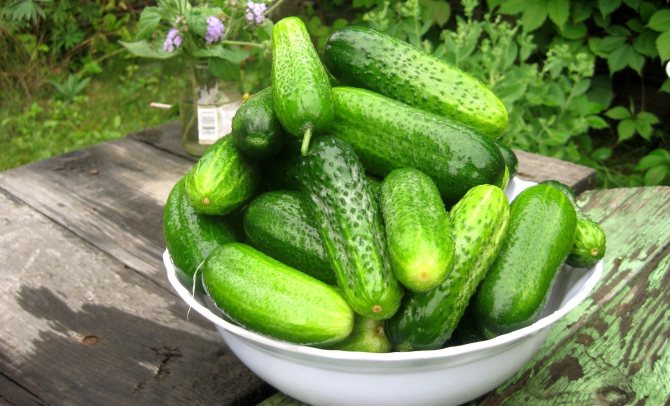

Cucumbers Podmoskovnye F1
Variety Mazay F1
One of the earliest among the parthenocarpic ones - these are the reviews about the Mazai f1 cucumber that are most often heard in his address. He loves light, shows resistance to almost all diseases. Forms 2-3 ovaries in one node. Fruits are gherkin, inexpressive tuberosity, average pubescence. Cucumber weight - 80-100 g, length - 13 cm. On average, the total weight of fruits obtained from 1 square meter is 13 kg.
Blizzard F1 variety
The earliest varieties with similar characteristics include the Vyuga F1 variety, obtained by St. Petersburg breeders. Many reviews about the Blizzard f1 cucumber speak of its peculiarity to grow in breadth after the fruit reaches a length of 5.5-6 cm. Such cylindrical barrels with tubercles make the variety especially attractive in appearance.
Peking gourmet F1 variety
The most unusual - such reviews about the cucumber Beijing gourmet f1 can be found on almost every forum of gardeners. All thanks to the shape of the fruits: unusually elongated (≈35-40 cm), dark green (almost black), densely covered with tubercles, they amaze with their appearance and appearance and an unusually sweet, almost dessert taste. This variety is used mainly for making fresh salads.
Variety Alekseich F1
Approval of the Alekseich f1 cucumber is justified by beautiful, cylindrical cucumbers 6-8 cm in length, weighing about 60 grams. They do not taste bitter at all, and there are practically no tubercles and sharp spines on their crust. Such bunch cucumbers give a good harvest - 12-14 kg. Very early variety: the growing season only lasts 38-42 days.
Variety Christina F1
A distinctive feature of the Christina f1 variety is good transportability, resistance to many diseases and drought. In general, the cultivation of Christina f1 cucumber in the open field does not require much effort, and parthenocarpicity allows you to get good yields. Medium-sized fruits - 80-110 g, taste - high.
Asterix F1 - bee-pollinated variety
If, nevertheless, the farmer decided to grow varieties with classic cross-pollination, then the Dutch variety Asterix F1 is perfect for this purpose.
True, it is not recommended for all areas. It is best to grow it without greenhouses in the central regions of Russia.
Turning to the opinion of others on the Internet, you can find out reviews about the Asterix f1 cucumber as the best variety for mass cultivation for sale. This popularity is due to the fact that it is a very hardy hybrid. And he doesn't care about drought, and his resistance to diseases is complex, and at the same time, the yield is decent. In addition, its fruits are standard sizes, attractive in appearance and have excellent taste. Medium-sized cucumber: weight - 80 g, length - 11 cm. The tuberosity is moderate, the thorns are infrequent, white. The skin is green with small and dull stripes. The pulp is juicy, dense, crispy, not bitter. Suitable for all types of processing and fresh consumption.
There are a huge number of self-pollinated varieties. For example, there are also such: Christina f1, Thumbelina f1, Asterix f1, Taganay, Junior Lieutenant f1. Read the article: The best indoor cucumber varieties for growing on the windowsill.
Advantages and disadvantages
Gardeners prefer this hybrid for the following reasons:
- Productivity - with sufficient fertilization and regular watering from a bush, you can collect from 3 kg of cucumbers.
- Presentation - cucumbers for ripening are leveled in size, overgrowth and casking are not typical for the hybrid.
- Size - the fruits are small, which allows them to be used for various preparations.
- Taste - there is no bitterness, the pulp is dense and juicy.
- Immunity - there is no need to fear epidemics.
Video
You can also watch this video, where a gardener with great experience will tell you how to pinch cucumbers correctly.
Cucumber Sigurd F1 was appreciated by gardeners who like to get an early tasty harvest without much hassle. The bushes cope with stress, do not get sick and do not require time to take care of.
| Pick-up location | Ripening terms | Mode of application | Fruit length | Group | Fruit smoothness | Pollination method |
| Universal | Early ripe (35-45 days) | Universal | Medium - from 10 to 15 cm | Hybrid | Heavily hilly | Parthenocarpic |
Features of agricultural technology
For sowing, you will need to purchase seeds and conduct a disinfectant treatment. After that, you can place the material in pots for seedlings, or immediately in unprotected soil.
The seedling period lasts no more than 20-30 days, then the seedlings are moved to greenhouses or street beds. When placing cucumbers, it is necessary to observe a distance of 50 cm. 2-3 bushes are enough for m2 in a shelter, in unprotected ground you can plant up to 4-5 plants.
It is more convenient to lead cucumbers in a vertical way, side shoots are removed from 2-3 leaves. Care consists in watering, loosening and regular feeding, preferably with a mineral composition.
Sowing seeds for seedlings
Planting seedlings in a greenhouse / greenhouse
Planting seedlings in OG
Stepping
Harvesting (in the greenhouse / in the exhaust gas)
How to grow a Cellar
Cucumber Prestige
This variety is not suitable for greenhouse cultivation as it is pollinated by bees. The cucumber forms female flowers, that is, the ovary is already present in them. The length of the lashes reaches 60-70 cm. For them, it is advisable to use a trellis with a stretched mesh. It is enough just to direct the stem at it and then the cucumber itself will trudge along it. It actively releases side shoots.
Important! When harvesting, you need to take good care of the stems. Do not move them, you need to try not to step on with your foot, as the damaged trunk can quickly dry out.
Leaves are wide, slightly drooping.
The plant loves warmth and moisture, therefore, before planting it in the ground, you must wait for warm weather. This can be done at the end of May and the first shoots will appear on the 3-5th day. The place for planting seeds should be chosen away from drafts and winds. In the greenhouse, seeds are planted for seedlings in early May. Seeds must be soaked to comfort germination. They are buried in the ground to a depth of no more than 2 cm.
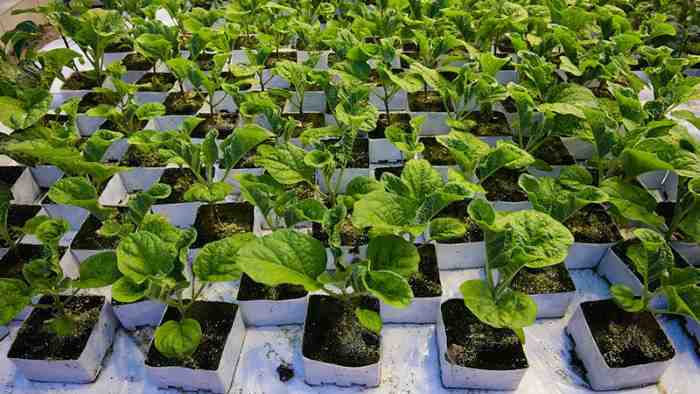

Seedling cucumber Cellar
Cucumber seedlings The cellar is planted when the temperature no longer drops below 18 degrees.
note! If the nights are cold, cover the seedlings with foil. If this is not done, its development slows down.
The cucumber can be grown in a variety of soils. If the land is not rich in nutrients, the plants need to be fed regularly. In one place, it can be grown for no more than 5 years. It is better to constantly change the place, this serves as protection against pests and various diseases. Great for planting cucumber ground field of tomatoes, potatoes, peas, corn.
Testimonials
- Seed germination is at a height, seedlings germinate a little earlier than open plantings, but by the fruiting season the plants are leveled. Zelentsy are small, dense. Due to their modest size, the cucumbers quickly saline and remain the same crisp and elastic (Vladimir, Moscow region)
- Cucumbers do not respond to sudden cold snaps, continuing to develop in growth. Preventive treatments are rare. You can harvest often, every 3 days (Olga, Ryazan).
- Like any cucumber, Espagnolette loves water. You need to water the plantings regularly, especially if the beds are greenhouse. In general, caring for the plants will not cause trouble, the yield is decent - up to 6 kg (Nikita, Kazan).
The cucumber has genetic immunity to common diseases, the fruits are dense, even. Suitable for all types of processing.
Disease resistance of the hybrid
The description of the species, as the most disease-resistant domestic hybrid, is confirmed by the numerous reviews of gardeners growing vegetables.
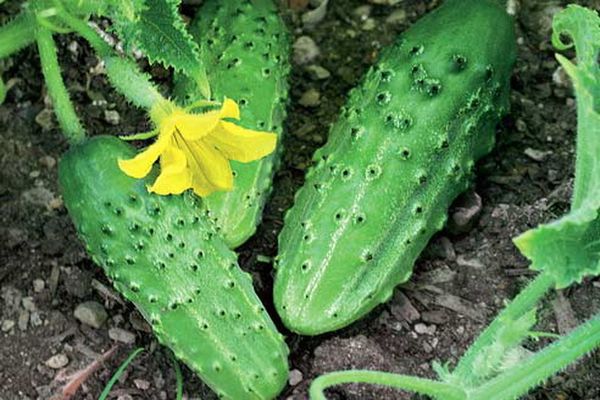

The plant is practically immune to downy mildew, cladosporium.
The general rules of soil preparation, processing of young plants to prevent the development of diseases should be observed. You can not plant vegetables in the ground where beans or carrots used to grow in order to prevent the spread of white rot that affects these crops. As soon as symptoms of powdery mildew or white rot are found, the leaves of the plant should be immediately sprayed with copper-containing preparations.
Sometimes the leaves of the cucumber Cellar are affected by the melon aphid. Spraying with a solution of laundry soap or modern preparations such as Biotlin, Fufanon will help to cope with the parasite.
Cucumber All Bunch F1
With a parthenocarpic hybrid of a bouquet type of flowering All by beam F1 you will always have a big harvest! For example, ten bushes are enough for a family of six. And with timely feeding, more than 7 kg of cucumbers can be harvested from each bush. The hybrid is early maturing, 40-42 days from germination to fruiting. Suitable for greenhouses and open ground. Forms at least 3 cucumbers in each node, and even more on lateral shoots. Zelentsy are short, not prickly at all, crispy and juicy, never bitter. This cucumber is of universal use.
